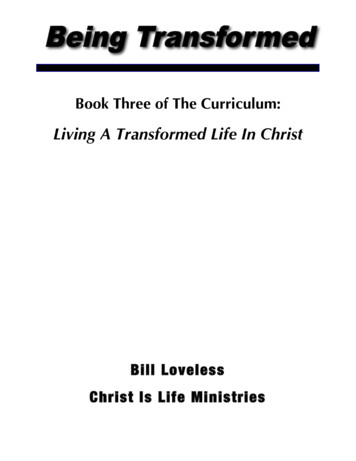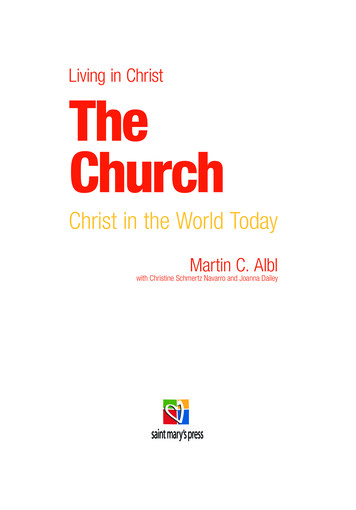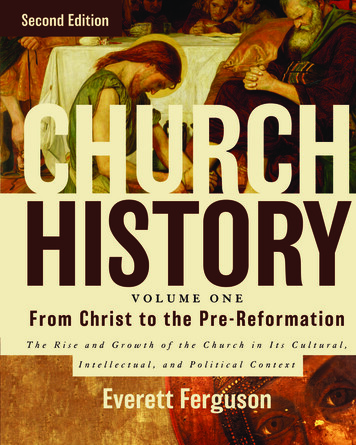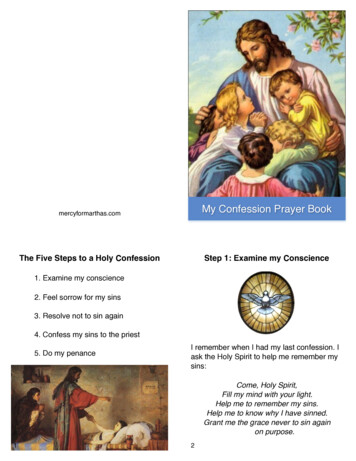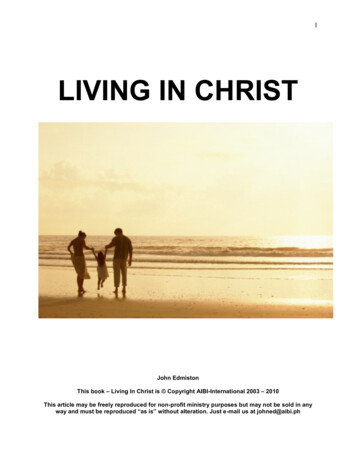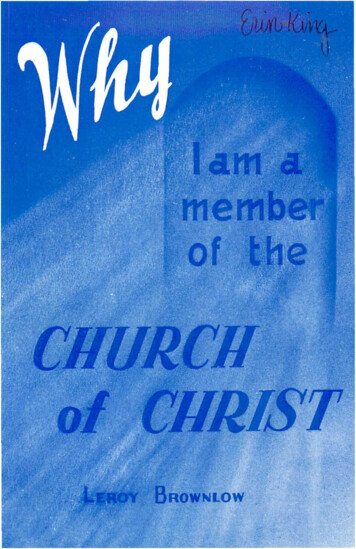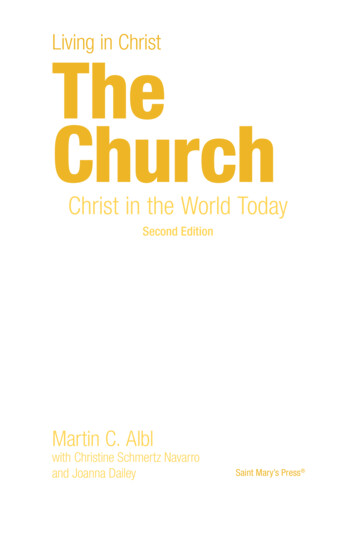
Transcription
Living in ChristTheChurchChrist in the World TodaySecond EditionMartin C. Alblwith Christine Schmertz Navarroand Joanna DaileySaint Mary’s Press
Copyright 2016 by Saint Mary’s Press, Christian Brothers Publications,702 Terrace Heights, Winona, MN 55987-1320, www.smp.org. All rightsreserved. No part of this book may be reproduced by any means withoutthe written permission of the publisher.Printed in the United States of AmericaE1164ISBN 978-1-59982-698-1
ContentsIntroduction. . . . . . . . . . . . . . . . . . . . . . . . . . . . . . . . . . . . 7Unit 1 The Church: Christ’s ContinuedPresence and Work in the WorldChapter 1 The Origin of the Church . . . . . . . . . . . . . 10Article 1 The Meaning of Church. . . . . . . . . . . . . . . . . . . 11Article 2 Old Testament Images of the Church. . . . . . . . 13Article 3 Christ Instituted the Church . . . . . . . . . . . . . . . 16Chapter 2 The Holy Spirit and the Church . . . . . . . . 21Article 4 Introducing the Holy Spirit. . . . . . . . . . . . . . . . . 22Article 5 Pentecost: The Church Revealedto the World. . . . . . . . . . . . . . . . . . . . . . . . . . . . 24Article 6 The Meaning of Pentecost . . . . . . . . . . . . . . . . 26Article 7 The Holy Spirit Builds, Animates,and Sanctifies the Church. . . . . . . . . . . . . . . . . 28Article 8 Images of the Holy Spirit. . . . . . . . . . . . . . . . . . 29Article 9 Life according to the Holy Spirit . . . . . . . . . . . . 31Article 10 Charisms: The Holy Spirit’s SpecialGraces for the Church. . . . . . . . . . . . . . . . . . . . 34Chapter 3 The Work of the Early Church. . . . . . . . . . 39Article 11 The Church Continues Christ’s Mission . . . . . . 40Article 12 How Did the Early Church Spreadthe Gospel?. . . . . . . . . . . . . . . . . . . . . . . . . . . . 42Article 13 Persecution and Martyrdom . . . . . . . . . . . . . . . 46
Unit 2 The Church Is One, Holy,Catholic, and ApostolicChapter 4 The Church Is One . . . . . . . . . . . . . . . . . . 54Article 14 The First Mark of the Church . . . . . . . . . . . . . . 55Article 15 Bonds of Unity. . . . . . . . . . . . . . . . . . . . . . . . . . 59Article 16 Divisions That Wound Christian Unity. . . . . . . . 64Article 17 Ecumenism . . . . . . . . . . . . . . . . . . . . . . . . . . . . 68Article 18 The Church of Christ. . . . . . . . . . . . . . . . . . . . . 72Chapter 5 The Church Is Holy. . . . . . . . . . . . . . . . . . 74Article 19 The Church’s Holiness . . . . . . . . . . . . . . . . . . . 75Article 20 The Church Makes Us Holythrough God’s Grace. . . . . . . . . . . . . . . . . . . . . 79Article 21 The Communion of Saints . . . . . . . . . . . . . . . . 82Article 22 The Saints: Models and Intercessors . . . . . . . . 84Article 23 Mary: Perfect Model of Holiness. . . . . . . . . . . . 87Chapter 6 The Church Is Catholic. . . . . . . . . . . . . . . 92Article 24 The Meaning of the Word Catholic . . . . . . . . . . 93Article 25 Catholicity: The Fullness of Christin the Church. . . . . . . . . . . . . . . . . . . . . . . . . . . 94Article 26 The Church’s Relationshipwith All People. . . . . . . . . . . . . . . . . . . . . . . . . . 97Article 27 Universality and Diversity . . . . . . . . . . . . . . . . 101Chapter 7 The Church Is Apostolic. . . . . . . . . . . . . 108Article 28 The Church Is Apostolic in Three Ways . . . . . 109Article 29 The Apostles Continued Jesus’ Mission. . . . . 109Article 30 Apostolic Tradition. . . . . . . . . . . . . . . . . . . . . . 112Article 31 The Successors to Peterand the Apostles. . . . . . . . . . . . . . . . . . . . . . . 116Article 32 The Apostolate of the Laity. . . . . . . . . . . . . . . 119
Unit 3 Leadership and Ministrywithin the ChurchChapter 8 The Leadership Structureof the Church. . . . . . . . . . . . . . . . . . . . . . . . . . . . . . . . 124Article 33 The Church and Hierarchy. . . . . . . . . . . . . . . . 125Article 34 The Pope: Visible Headof the Church. . . . . . . . . . . . . . . . . . . . . . . . . . 128Article 35 The Role of the Bishopsin the Church Hierarchy. . . . . . . . . . . . . . . . . . 131Article 36 The Priesthood . . . . . . . . . . . . . . . . . . . . . . . . 135Article 37 The Diaconate. . . . . . . . . . . . . . . . . . . . . . . . . 139Chapter 9 The Magisterium: The Teaching Officeof the Church. . . . . . . . . . . . . . . . . . . . . . . . . . . . . . . . 144Article 38 What Is the Magisterium?. . . . . . . . . . . . . . . . 145Article 39 Sacred Tradition, Sacred Scripture,and the Magisterium. . . . . . . . . . . . . . . . . . . . 147Article 40 Indefectibility and Infallibility. . . . . . . . . . . . . . 149Article 41 The Magisterium and Truth. . . . . . . . . . . . . . . 153Chapter 10 Many Vocations to Holiness. . . . . . . . . . 157Article 42 The Evangelical Counsels. . . . . . . . . . . . . . . . 158Article 43 The Priestly, Prophetic, and KinglyMission of the Laity. . . . . . . . . . . . . . . . . . . . . 161Article 44 The Vocation of the Laity. . . . . . . . . . . . . . . . . 165Article 45 The Consecrated Life: Religious Orders. . . . . 168Article 46 Other Types of Consecrated Life . . . . . . . . . . 171
Unit 4 The Church’s Mystery and MissionChapter 11 Images of the Church. . . . . . . . . . . . . . . 178Article 47 The Church Is the People of God . . . . . . . . . . 179Article 48 The Church Is the Body of Christ . . . . . . . . . . 182Article 49 The Church Is the Templeof the Holy Spirit . . . . . . . . . . . . . . . . . . . . . . . 186Chapter 12 The Church and Salvation . . . . . . . . . . . 190Article 50 The Fullness of Truth and Salvation . . . . . . . . 191Article 51 Salvation for Those outside the Church . . . . . 194Article 52 Who Needs Organized Religion?. . . . . . . . . . 198Chapter 13 The Church and the World . . . . . . . . . . . 202Article 53 Engaging the World. . . . . . . . . . . . . . . . . . . . . 203Article 54 Engaging Modern Culture. . . . . . . . . . . . . . . . 205Article 55 Evangelization and Inculturation. . . . . . . . . . . 208Unit 5 The Church and Young PeopleChapter 14 You Have Been Called . . . . . . . . . . . . . . 216Article 56 Called by God to Belong to the Church . . . . . 217Article 57 Christ Enriches Us throughParticipation in the Life of the Church. . . . . . . 220Article 58 Called to Community. . . . . . . . . . . . . . . . . . . . 225Chapter 15 Sent with the Holy Spirit. . . . . . . . . . . . . 230Article 59 You Are Sent as a Disciple . . . . . . . . . . . . . . . 231Article 60 Discipleship in Daily Life . . . . . . . . . . . . . . . . . 235Article 61 Empowered by the Holy Spirit . . . . . . . . . . . . 239Glossary . . . . . . . . . . . . . . . . . . . . . . . . . . . . . . . . . . . 243Acknowledgments . . . . . . . . . . . . . . . . . . . . . . . . . . . . 252
IntroductionYou are about to begin your study of the Church. In many ways, studyingthis subject will be similar to studying any other subject: you will learnnew vocabulary, become familiar with some famous people in the Church,and be introduced to some new concepts and ways of thinking.But in other ways, this study will be unique, because the subject matter is unique. The Church is unlike any other reality on earth, because sheis both within history and beyond it. She is both human and divine. In theChurch, we meet God.This study will engage not only your brain but also your heart andyour spirit: in other words, your whole self. You will be challenged mentally to understand teachings about the nature of the Church and to gaina sense of how she has been present in the world throughout history.You also will be challenged to pray more deeply with the Church and tobecome a more committed and active member of the Church. After all,you are a holistic person, made up of body, mind, and spirit. This studywill help you to broaden and deepen all aspects of yourself.In writing this book, the editors and I have expanded our knowledgeabout the Church, thought in new ways about the Church, and grown inour own commitment to, and love for, her. I invite you to share in thatexperience.Sincerely,Martin C. Albl
Unit1The Church: Christ’sContinued Presenceand Work in the WorldWhen you hear the word Church, what comes tomind? Perhaps you think of a building where Christians worship, or maybe you picture the assembly ofpeople gathered for worship. You may have learnedthat the Church is sometimes referred to as the Body ofChrist or the Bride of Christ. All these associations arecorrect.In this course, you will learn about the Church asthe continuation of Christ’s presence and work in theworld. The Father always planned the Church, and hisSon, Jesus Christ, instituted the Church through histeachings, sacrificial death, and Resurrection. Christand his Church are forever united as one. Christ isthe Head and we are the members of the one Body ofChrist, the Church.After Jesus’ mission was accomplished on earth,the Holy Spirit was poured out on the Church atPentecost to help the Apostles understand what Christhad taught them. Empowered and guided by the HolySpirit, Peter, Paul, and the other Apostles embarkedon the universal mission of the Church by workingto spread the Gospel throughout the Mediterraneanworld. The early Christians suffered persecution andeven martyrdom as a result of their faith, but Christ’slove and the Holy Spirit helped them to persevere insharing and celebrating the truth of Christ. The HolySpirit gives each of us special gifts, called charisms, thatempower us to help build up the Church in every timeand place.
The enduring understandings and essential questionsrepresent core concepts and questions that are exploredthroughout this unit. By studying the content of eachchapter, you will gain a more complete understandingof the following:Enduring Understandings1. God calls all people to live in a special relationshipwith him through the Church established by JesusChrist.2. The Holy Spirit is the principal agent of the Church’smission.3. The Apostles and early disciples began to spread theGood News throughout the world.Essential Questions1. Why did Jesus Christ establish the Church?2. What is the mission of the Holy Spirit in the Churchtoday?3. How can we help build the Church?
Chapter1The Originof the ChurchIntroductionWhere did the Church come from? Who founded it?As we begin our study of the Church, it makes sense tostart by considering these basic questions. The Churchwas always part of the Father’s plan. It was institutedby his Son, Jesus Christ, and is given life by the HolySpirit.The word Church refers to the assembly of peoplewhom God calls together to be in a special relationshipwith him. The Church was part of God’s saving planfrom all eternity. It is both the means of our salvationand the goal of God’s plan. All people who are savedwill be gathered into the perfected Church at the endof time.God formed a special relationship with Israel, hisChosen People. That relationship foreshadowed hissubsequent relationship with the Church. God’s covenants with Israel prepared the way for the New Covenant established through Jesus’ death and Resurrection.Jesus’ gift of the Eucharist and his saving death onthe cross gave birth to the Church. Jesus inauguratedthe Church by preaching about the Kingdom of God,healing people in mind and body, and calling people tobe part of his family. Jesus also established a structurefor the Church, based on the leadership of the Apostles, especially Peter. This structure will last until theKingdom is fulfilled.10
Chapter 1 The Origin of the Church11Article 1: The Meaning of ChurchLet’s begin by clarifying the meaning of the wordchurch. In everyday English, we use the word church torefer to different realities, such as a building (“the bigchurch downtown”), a parish (“I’m a member of SaintMary’s Church”), a Christian ecclesial community (“theLutheran Church”), and the Catholic Church. To understand how these meanings of church are related, it ishelpful to see how the earliest Christians understood andused this word.The books of the New Testament were originallywritten in Greek. In these books, the Greek word ekklesia corresponds to the English word church. Ekklesia isrelated to the Greek verb ek-ka-lein, which means “tocall out.” Thus it refers to the convocation or assembly ofpeople whom God calls together to be in a special relationship with him. The Greek texts of the Old Testamentalso use the word ekklesia to refer to the people of Israel,an assembly chosen by God. The first Christians purposely applied the term ekklesia to themselves to showthat they were heirs of the assembly of Israel.In the Church, God calls people together from allover the earth. The word Church has three meanings forCatholics, all of which involve God’s call: the entire community of God’s People around theworld the local community, which is known as a diocese oran archdiocese, such as the Diocese of Winona or theArchdiocese of Chicago the community assembled for liturgy, especially theMass—for example, the people who gather at a parishat 10:00 a.m. on Sunday to celebrate the EucharistWe cannot separate these meanings from one another.The Church is all the people God gathers in the world,but she exists concretely in local communities and ismade real in the assembly that gathers for liturgy, especially to celebrate the Eucharist. As the Catechism of theChurchThe term Churchhas threeinseparablemeanings: (1) theentire People ofGod throughoutthe world; (2) thediocese, whichis also known asthe local Church;(3) the assemblyof believersgathered for thecelebration of theliturgy, especiallythe Eucharist. Inthe Nicene Creed,the Church isrecognized as One,Holy, Catholic, andApostolic—traitsthat together arereferred to as“Marks of theChurch.”dioceseAlso known asa “particular” or“local” Church,the regionalcommunity ofbelievers, whocommonly gatherin parishes, underthe leadershipof a bishop. Attimes, a dioceseis determinednot on the basisof geography buton the basis oflanguage or rite.
12Unit 1 The Church: Christ’s Continued Presence and Work in the WorldliturgyThe Church’sofficial, public,communal prayer.It is God’s work, inwhich the Peopleof God participate.The Church’s mostimportant liturgyis the Eucharist, orthe Mass.Catholic Church (CCC) explains, “She draws her life fromthe word and the Body of Christ and so herself becomesChrist’s Body” (752). FABIO FRUSTACI/EPA / LANDOVThe hierarchy of bishops and cardinals come from a wide range of nationalities, ethnicities, and backgrounds, reflecting the diversity of the Church.Live It!Living the Three Meanings of ChurchYou have many opportunities to live out each of the three meanings of theword Church:1. Develop a better sense of the universal nature of the Church. You mightlearn about Catholic customs in other countries or pray for Catholics inother nations, especially those suffering persecution. You might also have anopportunity to attend World Youth Day.2. Get involved with your local diocese. Attend diocesan events for teens. Ifyour diocese has a youth board, consider serving as a member.3. Participate fully in the liturgies at your parish and school. Look for opportunities to serve in particular liturgical ministries, such as singing in the choir orlectoring.
Chapter 1 The Origin of the Church13The Father Planned the Churchfrom the BeginningCalling together human beings is central to the Father’splan of salvation, because he wishes to gather us as hisown people in order to save us. Jesus Christ, the only Sonof God, who is himself fully God, established the Churchwhen he proclaimed and ushered in the Kingdom of God.Even before the Church was instituted, the Father’seternal plan to call together a holy people had long beentaking shape in history. We can see the clearest preparation for the Church in the Father’s call to the people ofIsrael to enter into a covenant relationship with him. Goddesires that the whole human race, rather than simplyone people, may come together as one Church. From alleternity, God planned to form a Church as a way to fulfillthat plan.If everyone were to come together as one Church,how might the world be different?Article 2: Old Testament Imagesof the ChurchHave you ever wondered why more than half of the Bibleis composed of books that were written before the time ofChrist? The reason is that the Old Testament has enormous value. Together with the New Testament, it handson God’s Revelation and makes known to us his plan ofsalvation from the beginning of time. The Old Testamentrecords the history of salvation from Creation throughGod’s covenant with the Israelites.In describing his Church, Jesus often drew on OldTestament images. For example, the Psalms depict Israelas God’s flock of sheep (see 77:21). Jesus likewise referredto his followers as his “little flock” (Luke 12:32). Isaiah also compared Israel to a vineyard (see chapter 5).Accordingly, Jesus called himself the vine and his disciples the branches (see John 15:5). Saint Mary’s Press / Used withpermission of St . Mary’s Catholic ChurchHow does celebrating theEucharist in our local parishreflect the three meanings ofthe word Church?Kingdom of GodThe culmination orgoal of God’s planof salvation, theKingdom of God isannounced by theGospel and presentin Jesus Christ.The Kingdom is thereign or rule of Godover the heartsof people and, asa consequenceof that, thedevelopmentof a new socialorder based onunconditional love.The fullness ofGod’s Kingdomwill not be realizeduntil the end oftime. Also calledthe Reign of Godor the Kingdom ofHeaven.
14Unit 1 The Church: Christ’s Continued Presence and Work in the WorldFathers of theChurch (ChurchFathers)During the earlycenturies of theChurch, thoseteachers whosewritings extendedthe Tradition ofthe Apostles andwho continueto be importantfor the Church’steachings.foreshadowTo represent orprefigure a personbefore his or herlife or an eventbefore it occurs.Following Christ’s example, the early Christians oftencompared the Church to Israel’s Temple. They calledthemselves “living stones” who form a “spiritual house”(1 Peter 2:5). They described their community as “thetemple of God” (1 Corinthians 3:16, 2 Corinthians 6:16)with Christ as the cornerstone (see 1 Peter 2:7, Matthew21:42).Another Old Testament image was dear to theChurch Fathers: the prefiguring of the Church in Noah’sark. Many Fathers of the Church pointed out that the arksaved humankind from the waters of the Flood, whereasthe Church saves all of humanity from sin.God’s Covenants with IsraelAs these images from the Old Testament begin to show,the community of Israel foreshadowed the Church. Just asGod chooses to save us as part of the Church, so too didhe call Israel as a nation to be his Chosen People as partof his larger plan of salvation.Pray It!Praying the PsalmsJews and Christians continue to share the custom of praying the Psalms.Pray the following passage from Psalm 139, especially at times whenyou may struggle with your self-worth:You formed my inmost being;you knit me in my mother’s womb.I praise you, because I am wonderfully made;wonderful are your works!My very self you know.My bones are not hidden from you,When I was being made in secret,Fashioned in the depths of the earth.Your eyes saw me unformed;in your book all are written down;my days were shaped, before one came to be.(Verses13–16)
Chapter 1 The Origin of the ChurchGod called Abrahamto leave his own country,promising that Abrahamwould father a great nation,Israel (see Genesis 12:2).Later God made a covenantwith Abraham, promisinghim land for himself andhis descendants (see chapter15). Still later God enteredinto a covenant with hispeople through Moses atMount Sinai. As the people’spart of the Sinai Covenant, Scala / Art Resource, NYGod gave Israel his Law, summarized in the Ten Commandments. Through these covenants God established aspecial relationship with Israel as his Holy People.Universal Implications of God’sCall to IsraelGod’s special relationship with Israel was not just aboutIsrael—it had a deeper meaning for the rest of the worldas well. The prophets of Israel proclaimed a future whenall nations would gather together with Israel in true worship (see Isaiah 2:2–5, Micah 4:1–4). The gathering of thepeople of Israel foreshadowed the future gathering of allnations into one People of God.The Israelites, however, were not always faithful totheir covenant with God. For example, many Israelitesfrequently strayed from the one true God to worshipfalse gods. Through the prophets of Israel, God continually called the Israelites to return to their covenant withhim. The prophet Jeremiah even spoke of God’s planfor a New Covenant between God and his people (seeJeremiah 31:31–34).The perfect fulfillment of the Sinai Covenant, theLaw, is the Son of God, Jesus Christ. As a Jew he wasborn under the Law of Sinai. But by taking the people’ssins upon himself through his self-sacrifice on the cross,15When the Israelites turned awayfrom God, Mosesinterceded with Godon their behalf. Howdoes this foreshadowJesus’ role as ourSavior?
16Unit 1 The Church: Christ’s Continued Presence and Work in the Worldhe transformed the Law engraved on stone and engravedit upon his own heart. He became the “covenant for thepeople” (Isaiah 42:6), God’s Servant who brings justice.In fulfilling the Law of Sinai, however, Jesus did not abolish it. Instead he revealed its true meaning. Jesus thusinitiated the New Covenant at the Last Supper: “This cupis the new covenant in my blood, which will be shed foryou” (Luke 22:20).What are some examples of “false gods” that peopleworship today?Article 3: Christ Institutedthe ChurchWhen you think of people instituting an organization orcorporation, you may think of a ceremony in which menand women dressed in business suits and hard hats useshovels to break ground on a new structure. Jesus did notinstitute the Church in this way. Let’s look more closely athow Jesus did institute the Church.Primary SourcesVatican II Teaching on the Church’s Relationto the Jewish PeopleIn its Declaration on the Relation of the Church to Non-Christian Religions(Nostra Aetate, 1965), Vatican Council II affirmed that God loves the Jewish people and decries all oppression of Jews. Many Jews have sufferedunjust treatment because the sins of the Jews involved in Jesus’ death werewrongly extended to include all Jewish people, even those in different timesand places.Nevertheless, God holds the Jews most dear for the sake of their Fathers;He does not repent of the gifts He makes or of the calls He issues—suchis the witness of the Apostle. . . . Although the Church is the new peopleof God, the Jews should not be presented as rejected or accursed byGod, as if this followed from the Holy Scriptures. (4)
Chapter 1 The Origin of the Church17Jesus Preached the Kingdom of GodAt the time appointed by God, Jesus Christ, the EternalWord of the Father, became man and lived among uson earth. He took on human nature without losing hisdivine nature. The mystery of the union of the divineand human natures in one Divine Person is called theIncarnation.During his earthly ministry, Jesus inaugurated theChurch through his preaching: “This is the time of fulfillment. The kingdom of God is at hand” (Mark 1:15; seealso CCC, 763). Jesus drew on the hope announced byIsaiah and the other Old Testament prophets, who lookedforward to a coming age when God’s will would be doneon earth: “Then the eyes of the blind shall see, / and theears of the deaf be opened” (Isaiah 35:5).Jesus’ message was intended for all people. Yet in aspecial way, Jesus directed his message to the poor andproclaimed that all nations will be judged on how wellthey take care of people who are hungry and thirsty(see Matthew 25:31–46). Jesus also directed his messagetoward sinners, calling them to repentance and assuringthem of the Father’s great mercy. Jesus’ message oftentook the form of parables, which challenged listeners tomake the radical choice to truly follow him.Jesus’ listeners learned about the Kingdom from hisactions as well as from his words. His miracles, includinghis healing of the sick, were signs that the Kingdom hadalready begun on earth.Jesus Sent DisciplesTo help Jesus establish theKingdom of God, the Fathergathered people to become hisfirst followers. Jesus sent outthese disciples to preach theKingdom and to make disciplesof the nations, calling all peopleto join Christ’s Church. Thisgroup of followers, his disciples,IncarnationFrom the Latin,meaning “tobecome flesh,”referring to themystery of JesusChrist, the DivineSon of God,becoming man. Inthe Incarnation,Jesus Christbecame truly manwhile remainingtruly God.During his earthlyministry, Jesuspreached the Kingdom of God. Howdoes the Gospelmessage continueto be taught today? Brooklyn Museum of Art, New York, USA / Bridgeman Images
18Unit 1 The Church: Christ’s Continued Presence and Work in the WorldgraceThe free andundeserved giftthat God gives usto empower us torespond to his calland to live as hisadopted sons anddaughters. Gracerestores our lovingcommunion withthe Holy Trinity, lostthrough sin.bishopOne who hasreceived thefullness of theSacrament of HolyOrders and is asuccessor to theApostles.became the Church—Jesus’ true family, and the seeds ofthe Kingdom on earth. The Church is thus a sign, as wellas the actual beginning, of that perfect peace and happiness that all of us desire: the Reign of God mysteriouslypresent in the world.Jesus Gave Himself Fully for the ChurchJesus established the Church primarily through the saving gift of himself, which was fulfilled on the cross. Heanticipated this gift when he instituted the Eucharist. Atthe Last Supper, when he said, “This is my body” (Luke22:19), he expressed his complete self-giving in handingover his life for the sake of humanity. By participating inthe Eucharist today, in a mystical way we share in Christ’ssacrifice and also in the grace that his sacrifice gives theChurch. The Sacrament of the Eucharist also deepens theunity of the People of God and enables us to share in thedivine life.Jesus Created the Structureof the ChurchHave you ever wondered why the Church is governed bythe Pope and bishops? Jesus set up this structure himself.He appointed the Twelve Apostles as the leaders of theDid You Know?Whom Does Jesus Call? Erich Lessing / Art Resource, NYWhen Jesus gathered followers to helphim proclaim and establish the Kingdom, he did not call the most talented andpowerful. Rather, he chose ordinary fishermen(see Mark 1:16–20) and even a tax collector(see 2:13–17)—a person despised by mostIsraelites. Jesus’ choices are consistent withSaint Paul’s reminder that “God chose theweak of the world to shame the strong” (1Corinthians 1:27). God’s call comes to everyone, even (or perhaps especially) to thosewho think they may not be worthy.
Chapter 1 The Origin of the Church19community gathered around him (see Mark 3:14–19),and he gave Peter a special role as the head of the Church(see Matthew 16:18–19, Luke 22:31).To build the Church and to proclaim the faith, Christsent out his Apostles into the world and gave them ashare in his own mission. To them, and to those whohave succeeded them, he granted the power and authority to act in his place. The bishops are the Apostles’successors, and the Pope, the Bishop of Rome, is thesuccessor of Peter. In their authoritative roles as leaders, together the Pope and bishops form the hierarchy ofthe Church. The structure and hierarchy of the ChurchFaith in ActionSaint Stephen: The First MartyrGood King Wenceslas looked outOn the feast of Stephen,When the snow lay round about,Deep and crisp and even.This familiar Christmas carol refers to thefeast of the first martyr of the Church,SaintStephen the Deacon. Because he was Zvonimir Atletic / Shutterstock .comthe first to lose his life for Christ, he was giventhe feast day of December 26, the first day after the birth of Jesus. This caroltells us that King Wenceslas (a historical tenth-century duke of Bohemia) waslooking out his castle window on December 26.Because Stephen stood up for the truth, he was stoned to death. Indeed,a young man named Saul (who later converted and became the great ApostlePaul) watched over the cloaks of those who stoned this first martyr of theChurch (see Acts of the Apostles 7:58).The acts of the Apostles says clearly that Saint Stephen died as Christ died.Stephen’s last words, addressed to Jesus, echoed Jesus’ own words to theFather: “Lord Jesus, receive my spirit” (Acts 7:59; see Luke 23:46). Stephenalso echoed Jesus’ prayer for forgiveness
the continuation of Christ's presence and work in the world. The Father always planned the Church, and his Son, Jesus Christ, instituted the Church through his teachings, sacrificial death, and Resurrection. Christ and his Church are forever united as one. Christ is the Head and we are the members of the one Body of Christ, the Church.


